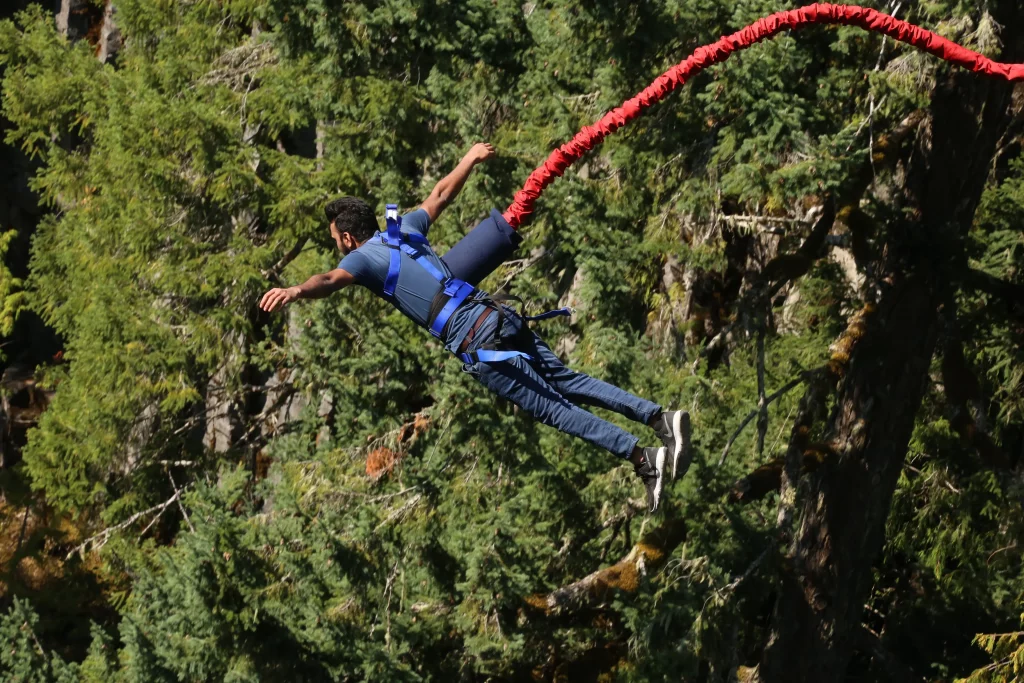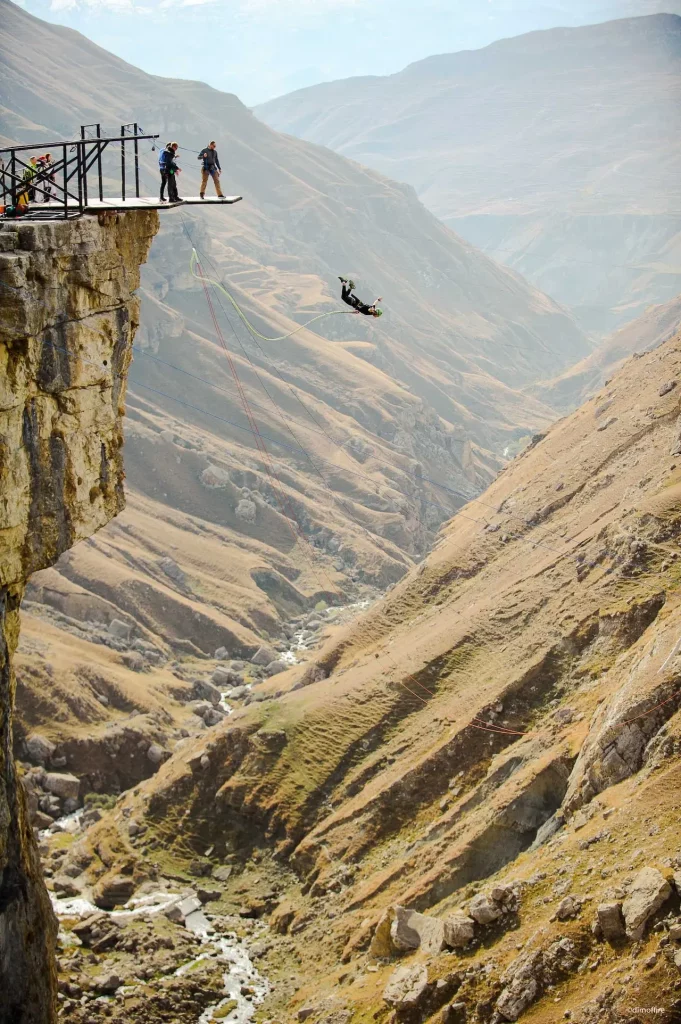Have you ever had the urge to jump from a bridge, building or even a hot air balloon while attached only by a stretchy elastic cord? If so, you’re not alone! Bungee jumping is an adrenaline-pumping extreme sport that has skyrocketed in popularity all around the world. Let’s strap in and explore the fascinating, gravity-defying world of bungee jumping.
What is Bungee Jumping Exactly?

Bungee jumping involves leaping from a high fixed structure while connected to an elastic bungee cord tied to both your feet and the jump site. The cord stretches as you fall then rebounds, catapulting you back up before you bounce around until all the kinetic energy dissipates. Bridges, buildings, cranes, cliffs, hot air balloons – you name it, and someone has probably bungee jumped off it!
You may reach speeds up to 120 mph during the free fall followed by a fairly abrupt deceleration. The harness and cord absorb that kinetic energy, giving you an exhilarating yo-yoing ride up and down. Don’t worry – despite the initial terror, the elastic cord brings you to a safe stop without smashing into the ground.
The Origins of Bungee Jumping
Believe it or not, bungee jumping dates back hundreds of years! The roots trace to the ritual land diving performed by males on the tiny South Pacific island of Pentecost in Vanuatu. These brave men jump off tall wooden platforms with vines tied to their ankles as a rite of passage to prove their courage.
The Oxford University Dangerous Sports Club brought bungee jumping into the modern era in the 1970s after hearing reports of the incredible land diving ritual. They made the first leaps from the Clifton Suspension Bridge in England, inaugurating bungee as a recreational sport.
In the 1980s, New Zealander A.J. Hackett pioneered commercial bungee jumping, making the thrilling activity accessible to the public. Hackett performed many headline-grabbing jumps, including from the Eiffel Tower, and opened the first permanent bungee jump site at the Kawarau Bridge in Queenstown. And the rest is extreme sports history!
Gearing Up: Bungee Jumping Equipment
The specific equipment you use depends slightly on the operator, but some standard bungee gear includes:
Bungee cord – This specialized elastic rope made from latex or rubber strands attaches to the platform and your body. Engineers carefully calculate the optimal cord length and elasticity for each jump.
Ankle harness – Straps or clamps go around your ankles to connect you securely to the bungee cord. They distribute force evenly.
Body harness – A full waist and shoulder harness similar to rock climbing provides backup protection and gets hooked to the cord.
Helmet – Helmets protect your head during the jump and in case of bouncing back up.
Many operators also use elaborately rigged cranes, cages, nets and safety harnesses for additional protection. Special clothing helps avoid painful skin friction burns from the high speeds.
World’s Highest Bungee Jumps
Adrenaline junkies are always trying to push the extremes by bungee jumping from higher and higher perches. Here are a few of the loftiest leaps currently possible:
Zhangjiajie Glass Bridge, China – At 260 meters (853 feet), this jump off a bridge with a glass walking section high over a gorge will have you screaming in terror!
Macau Tower, China – Jump 233 meters (764 feet) off this 338-meter tower for insane views of Macau’s gleaming casinos.
Verzasca Dam, Switzerland – Featured in the James Bond movie GoldenEye, the dam’s 220-meter (720-foot) bungee jump is one of the most famous.
Bloukrans Bridge, South Africa – Plummet 216 meters (709 feet) from Africa’s highest bridge near scenic Plettenberg Bay.
Europa Bridge, Austria – Leap 192 meters (630 feet) from this bridge with a view of the Austrian Alps.
Those are just a few of the many breathtaking bungee jumps available—new world records continue to be set!
Playing It Safe: Bungee Jump Safety

Like any extreme sport, bungee jumping poses some inherent risks. However, modern commercial operators have an excellent safety profile thanks to the extensive precautions they take.
- Rigorous training and certification for jump masters and staff
- Careful cord length calculations based on jumper weight
- Use of tested, high-quality equipment
- Regular equipment inspections and maintenance
- Detailed jump protocols and procedures
- Backup cords or safety harnesses in case of main cord failure
- Emergency medical personnel standing by
Even with all those measures, the nature of bungee jumping means accidents can rarely happen—so it’s not a risk-free activity. Potential injuries include:
- Leg or ankle fractures from the jerking force of the cord
- Dislocated joints from the abrupt deceleration
- Bruising where the harness attaches
- Collisions with the platform if you bounce back up
- Eyesight damage from pressure changes
Make sure to follow all staff instructions carefully. Pay attention during the safety briefing and jump protocol.
Any Fitness Level Can Bungee Jump
From elderly grannies to 10-year-old kids, almost anyone can safely enjoy bungee jumping since it doesn’t require peak physical fitness. There are some health precautions though:
- Age minimums, usually 12 to 14 years or older
- Weight limits to not overstress the equipment
- Restrictions if pregnant or might be pregnant
- Caution if you have heart, back, or neck problems
First-time jumpers often get extremely anxious right before leaping into the void. This is totally normal! The jump masters are very skilled at encouraging you and making sure you have all the support needed to take the plunge.
Many locations even offer circus tricks like jumps where you dunk into water or touch something with your hands. Don’t forget your certificate after to prove what a badass you are!
Thrilling Bungee Variations
If traditional bridge and platform bungee jumping seems tame, check out these variations for added twists:
Reverse bungee – Rocket skyward from the ground with the cord attached to a crane or tower.
Bungee trampoline – Get extra bounce from jumping onto a trampoline with bungee cords attached.
Running bungee – Run on a track with a bungee tied to your waist pulling you back.
SCAD diving – Free fall with no bungee into a net for the ultimate trust exercise.
Ramp jumps – Zip down a ramp on a bike, skis, or sled before leaping.
Don’t limit your imagination – you can try bungee jumping in all sorts of creative ways! Just make safety the top priority.
Final Thoughts: Take the Leap!
In our modern, mostly risk-averse society, bungee jumping provides a rare opportunity to truly challenge yourself and escape your comfort zone. For a few fleeting minutes, you get to fly like a bird and cheat gravity, untethered by daily life.
It’s both terrifying and liberating at the same time. Your heart races, time stands still, and you’re fully present in that singular moment of free fall. Then after an uncontrollable scream into the abyss, you’re flooded with elation from having conquered your fears.
Bungee jumping packs all the excitement most people will ever experience in a short action-packed experience. It’s an accessible way to get out of your rut and feel the thrill of extreme sports.
So if you’re debating taking the plunge, take a leap of faith! Sign up for a bungee jump, follow the safety protocol, and cross it off your bucket list. We dare you to just go for it – you’ll likely look back on it as a highlight adventure and one of the coolest things you’ve ever done.
The freedom of falling and rebounded flight awaits. It’s time to jump!
Frequently Asked Questions About Bungee Jumping
What does bungee jumping feel like?
The anticipation and fear leading up to the jump is usually the most intense part. Once you leap, your adrenaline surges and you may momentarily lose your breath. The free fall feels like your stomach dropping as the ground zooms closer. Then you rapidly decelerate with a jolt as the bungee cord recoils before rebounding skyward. Most describe an overwhelming rush.
Where can I go bungee jumping near me?
Commercial bungee jumping is available in many major tourist destinations worldwide. Operators often set up near bridges, on buildings, or at adventure sports parks. Search “[city] bungee jumping” to find options in your local area.
How much does bungee jumping cost on average?
Expect to pay anywhere from $70 up to $300, depending on the location and height of the jump. Multi-jump packages help lower the per-jump cost. Keep in mind you’re paying for the specialized staff, equipment maintenance, and insurance.
Can you die bungee jumping?
Deaths are extremely rare, but accidents can happen if safety protocols aren’t followed correctly. To stay safe, choose a reputable operator, listen carefully to all instructions, and make sure nothing detaches during the jump. Take your health history into account as well.
Is bungee jumping safe if you are over 50?
As long as you are in reasonable health, bungee jumping is generally safe for those over 50. Older jumpers may want to consult a doctor first about any medical concerns. Tell staff about any relevant health conditions and consider a lower jump on your first try.
How high do you have to be to bungee jump?
There is no set minimum, but jumps usually start around 50 meters (164 feet) high and go up to 260 meters (853 feet) for record attempts. First time jumps tend to be around 100-150 feet. The higher the altitude, the more free fall time you’ll have.
Read more:https://worldvisitguider.com/trip-to-himalayas/


